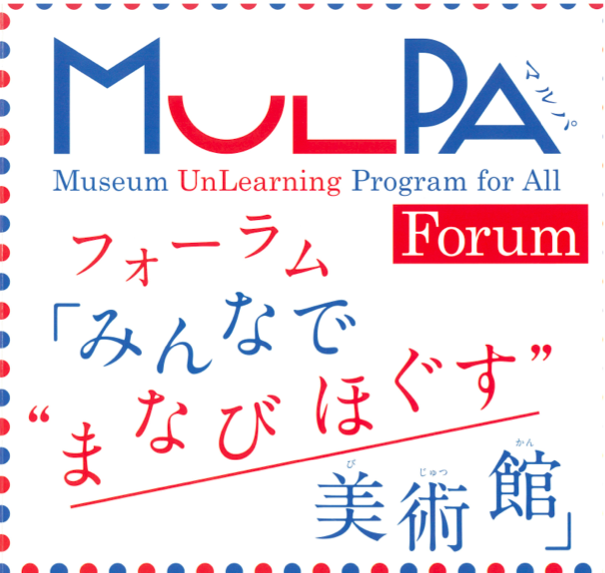At the end of 2017, I headed down south from Tokyo to the Chigasaki Museum of Art to see an exhibition by Michiko Fujita whom I had the pleasure of exhibiting with for the "Endless Dialogue" three-person show at Hasu no Hana. During my visit, I was introduced to the curator of the Chigasaki Museum of Art who was interested in learning more about my studio practice after hearing about my work from Michiko Fujita. The Chigasaki Museum of Art is working with other Kanagawa prefecture museums along with the Kanagawa International Foundation for the MULPA project.
The “MULPA: Museum UnLearning Program for ALL” is a first-of-its-kind program whose aim is to “make museums accessible” to “all members in the community” that was proposed by Kanagawa International Foundation, developed and launched last year by the directors, curators of four public museums and art festival coordinators in Kanagawa Prefecture. The project explores what kinds of educational programs and events of art museums can be put on toward the society to respect each other’s differences. Ahead of 2020, the year of the Tokyo Olympics, museums participating in MULPA will host a variety of art workshops that are inclusive to all members of society in order to make the museums community hubs in a true sense. The upcoming first MULPA event features a world café-type workshop whose goal is to promote sincere and lively discussion among museum curators as well as museum supporters including volunteers, civil organization members, university students and individuals who have difficulty visiting museums, including those facing physical and language-related barriers, about how museums can be made enjoyable for all.
We made plans to meet in early 2018 to discuss my studio practice and work in more detail to see if I might be a good fit for this project. After meeting and presenting my work to the core members of the Chigasaki Museum of Art team, I was invited to be part of this project which is tentatively planned for the summer of 2019. At the time, the shape of this project was still largely undecided and one of the ways to help give the project shape was to conduct a series of field research meetings under the theme of "The Road to the Art Museum". To date, there have been three field research meetings to date. The first one was an introduction to the project as well as discussions about accessibility for persons with disabilities. The second one was a discussion about inclusive design while the third one was about the use of sound as a means of making the museum more accessible. For each field research meeting, the structure is a brief presentation followed by field research which involves walking around the museum area and Chigasaki vicinity to put the presentations into context. Due to the logistics of moving around efficiently for the field research, the meetings have been limited to the participating core members and invited presenters. The Chigasaki Museum of Art has done a wonderful job of documenting each of the field research meetings so I have had a chance to see what each of the meetings has involved. While in Japanese, you can still get a sense of the shape of the meetings through the images.
My field research meeting is scheduled for the end of July. Ahead of my meeting, two of the core members, Shozo Kuze and Mariko Sakamoto, who compose the art and design unit, MATHRAX, currently have an exhibition, "Voices of Stones / いしのこえ" at the Chigasaki Museum of Art through July 1st.
Last Sunday, I went to the museum to hear their artist talk and see their work which won a Haptic Design Award in 2017. Before the artist talk, I decided to do a little bit of field research on my own to get started on preparations for my field research meeting. Being my third time to Chigasaki, I have become familiar with the winding route from the station to the museum. My first time was spent navigating curves and forks in the road eventually finding my way there.
At the entrance to the park where the museum is located there is a map of the area and it turns out the beach is only 15 minutes from the museum. I decided to make field recordings of my walk from the museum to the beach and back, taking a different route on the way back. Along the way, I started to think about where my studio practice and interests might intersect with this project.
The artist talk by MATHRAX was very interesting and informative as they explained their inspiration, concept, and production for the "Voices of Stones" project. I was so impressed with their work and presentation that I became a bit unsure about my inclusion and potential contribution to the MULPA project. Seeds of doubt and low level panic began to set in.
After the artist talk, I wandered around the installation taking in their work and thinking more about my role in this project. I also had a chance to speak with the artists along with the curator who was reassuring when she mentioned to me to remain open and not have any fixed ideas about my project and the upcoming field research meeting. I ended up at the museum for several hours speaking with other field research participants, artists and visitors. As I walked out of the museum to head back home, I came away with a sense of excitement at the possibilities of new ideas and collaboration.
From now until the end of July, part of my time will be spent thinking about "The Road to the Art Museum" and how it relates to my studio practice, especially to the Memory Walks Project and my work with Artfull Action and elementary students last fall.
As always, my intended two part post has seemingly ballooned to at least four parts. More to come.


